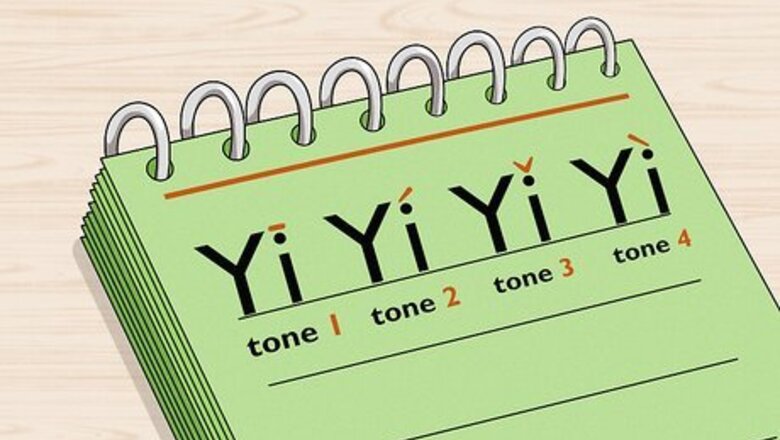
views
- Learn tones and sounds used in Mandarin. Memorize simple vocabulary, numbers, and basic conversational phrases to improve your fluency and pronunciation.
- Study basic Mandarin grammar and use the Pinyin phonetic system to learn pronunciation. Practice reading and writing Chinese characters as well.
- Practice speaking with a native speaker, take courses, and consume Chinese media. Be patient, as it takes about 2200 hours of study to become proficient in Mandarin.
Mastering the Basics
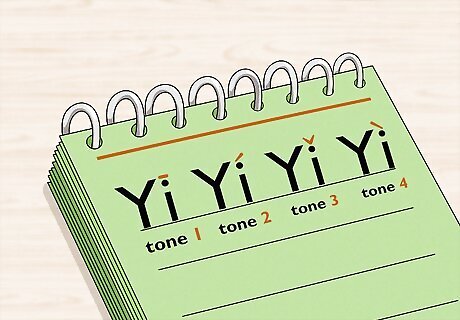
Practice using the four Mandarin tones. Mandarin Chinese is a tonal language, which means that different tones can change the meaning of a word, even if the pronunciation and spelling are otherwise the same. It is essential to learn the different tones if you wish to speak Mandarin Chinese correctly. Mandarin Chinese has four main tones, as follows: The first tone is a high, flat tone. Your voice stays flat, with no rise or dip in the way it sounds. Using the word "ma" as an example, the first tone is indicated using the symbol above the letter a: "mā". The second tone is a rising tone. Your voice rises from a low to middle pitch, as if you were asking someone to repeat something by saying "Huh?" or "What?" The second tone is indicated using the symbol "má". The third tone is a dipping tone. The pitch goes from middle to low to high, like when you say the letter "B". When two third-tone syllables are near each other, the second one retains its third tone sound while the first takes the sound of the second tone. The third tone is indicated using the symbol "mǎ". The fourth tone is a lowering tone. The pitch goes rapidly from high to low as if giving a command e.g. stop! Or as if you're reading a book and have come across something new and interesting and are saying "huh". The fourth tone is indicated using the symbol "mà". Listen to examples of the tones spoken by a native speaker. This will help you understand what each tone sounds like.
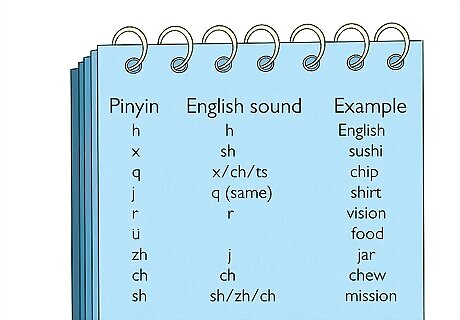
Learn the sounds that Mandarin uses. These sounds are represented for English speakers by a special phonetic writing system called “pinyin” (characters: 拼音). Each sound is represented by a letter from the English alphabet (or by a pair of letters, plus symbols), and most letters sound very similar to their English counterpart. The new sounds you'll have to learn include: "h", "x", "q", "j", "r", and "ü". There are also other letter combinations you need to learn, including "zh", "ch", and "sh". "h": Almost like English "h", but a little bit throatier. "x": Place the tip of your tongue near where your bottom teeth meet their gums and the middle of your tongue near the roof of your mouth. Then, blow air out of your mouth. It will sound similar to "sh", but closer to "s". "q": Just like "x" but use a "t" sound to start it. It will sound similar to "ch", but closer to "ts". "j": Similar to "q", but you'll need to use voice in this one. Instead of just breathing air out, do it with sound behind it. The difference between "q" and "j" is like the difference between "s" and "z" in English. "r": This letter makes a different sound when it's at the beginning of a syllable versus when it's at the end. When it is at the start, it's a tricky one and may need more practice. Take the tip of your tongue and lift it up until it almost touches the roof of your mouth. The sides of your tongue should touch around your back molars on either side. Then, breathe with your voice. It should almost sound like the "s" in "vision", but closer to "r". When this letter is at the end of a syllable, it sounds just like an "r" in English. "ü": This letter is the sixth vowel of Chinese, and is not one found in English. However, it is relatively easy to say. First, round your lips as if you were about to say "oo", as in "food". Then, make the sound of "ee" that you hear in "bee". "zh": Very similar to the English "j" in "jar", but position your mouth the same way as for Mandarin "r". "ch": Very similar to the English "ch" in "chew", but position your mouth the same way as for Mandarin "r". " sh": Very similar to the English "sh", but position your mouth the same way as for Mandarin "r". The sounds "r", "zh", "ch", and "sh" are known as the "retroflex" initials because they are a sound family of a sort.

Memorize simple vocabulary. This will help you become fluent. The more words you know, the faster this will happen. Begin by memorizing some useful Chinese vocabulary. Some good vocabulary lists to start with include: times of day (morning: zǎo shàng; 早上, afternoon: xià wǔ; 下午, evening: wǎn shàng; 晚上) body parts (head: tóu; 头, feet: jiǎo; 脚, hands: shǒu; 手) food (beef: niú ròu; 牛肉, chicken: jī; 鸡, egg: jī dàn; 鸡蛋, noodles: miàn tiáo; 面条) along with greetings, colors, days of the week, months, transport words, weather, etc. When you hear a word in English, think about how you would say it in Mandarin. If you don't know what it is, jot it down and look it up later. It's handy to keep a little notebook on you for this purpose. Attach little Chinese labels (with the character, the pinyin, and the pronunciation) to items around your house, such as the mirror, the coffee table, and the sugar bowl. You'll see the words so often that you'll learn them without realizing it! Although having a wide vocabulary is good, remember that in Mandarin, accuracy is more important. It's no good learning a word if you can't pronounce it properly, using the correct tone, as different pronunciations could have entirely different meanings. For example, using the wrong tone (using mā instead of má) could be the difference between saying "I want cake" and "I want coke" - two completely different meanings. Expert Answer Q When asked, “How long does it take to learn basic Mandarin?” Godspeed Chen Godspeed Chen Native Chinese Speaker & Translator Godspeed Chen is a Professional Translator from China. He has been working in translation and localization for over 15 years. Godspeed Chen EXPERT ADVICE Answer from Godspeed Chen: Godspeed Chen, a Chinese translator, responded: “It might take you one or two weeks to learn some useful expressions. Becoming fluent can take one or more years.”
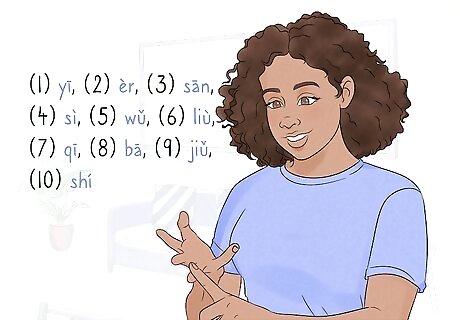
Learn how to count in Mandarin. The Mandarin numerical system is very straightforward and logical. Once you have learned the first ten numbers, you’ll be able to count to 99. Below you will find the numbers one to ten, written in simplified Chinese characters, followed by the Hanyu pinyin translation and the correct pronunciation. Make sure to practice saying each number using the correct tone. One: written as (一) or yī, pronounced [eee] Two: written as (二) or èr, pronounced [err] Three: written as (三) or sān, pronounced [saan] Four: written as (四) or sì, pronounced [ssuh] Five: written as (五) or wǔ, pronounced [oo] Six: written as (六) or liù, pronounced [lee-yoe] Seven: written as (七) or qī, pronounced [chi] Eight: written as (八) or bā, pronounced [baa] Nine: written as (九) or jiǔ, pronounced [jee-yoe] Ten: written as (十) or shí, pronounced [sh] Once you have mastered numbers one to ten, continue counting in double digits by saying the number in the tens' position, then the word 十, followed by the number in the one's position. For example: The number 48 is written as sì shí bā (四十八), literally meaning "four tens plus eight". The number 30 is written as sān shí (三十), literally meaning "three tens". The number 19 is written as yī shí jiǔ (一十九), literally meaning "one ten plus nine" (however in most Mandarin dialects the initial yī is omitted from numbers in the teens, as it is deemed unnecessary). The word for hundred in Mandarin is (百) or baǐ, so 100 is written as yì baǐ, 200 is written as èr baǐ, 300 is written as sān baǐ, etc.

Learn some basic conversational phrases. Once you have a basic grasp of vocabulary and pronunciation, move on to basic conversational phrases that are used in everyday Chinese speech. Hello- 你好- nǐhǎo, pronounced [nee how] What is your last name(surname)? (formal )- 您贵姓? - nín guì xìng, pronounced [neen gway shing] or 你姓什么?- nǐ xìng shén me (inf.), pronounced [nee shing shurn muh] What's your name?- 你叫什么名字? - nǐ jiào shén me míng zì, pronounced [nee jee-ou shurn muh ming zi] Yes- 是 - shì, pronounced [sh] No- 不是 - bú shì, pronounced [boo sh] Thank you- 谢谢 - xiè xiè, pronounced [shie shie] You're welcome- 不用谢 - bú yòng xiè, pronounced [boo yong shee-e] Excuse me- 对不起 - duì bu qǐ, pronounced [dway boo chee] I don't understand- 我不懂 - wǒ bù dǒng, pronounced [wuo boo downg] Goodbye- 再见 - zài jiàn, pronounced [zay jee-en]
Advancing Your Language Skills

Study basic grammar. There is a common misconception that grammar does not exist in the Chinese language, but this is not true. Chinese grammar rules do exist, they are just very different from those in Indo-European or other language systems. Unlike these languages, Chinese is a very analytic language which is both good news and bad news for language learners. For instance, in Chinese, there are no complicated rules about conjugations, agreement, gender, plural nouns, or tenses. Most words consist of single syllables which are then combined to make compound words. This makes sentence construction fairly straightforward. However, Mandarin Chinese has other grammar rules that are not found in English or other Indo-European languages. For example, Mandarin uses grammatical features such as classifiers, topic-prominence, and preference for aspect. As these features are not used in English, they can be quite difficult for learners to grasp. However, despite the differences, Mandarin usually uses the same word order as English: subject - verb - object. This makes it possible to translate between the languages word-for-word. For example, the English phrase "he likes cats" is translated directly as "tā (he) xǐ huan (likes) māo (cats).
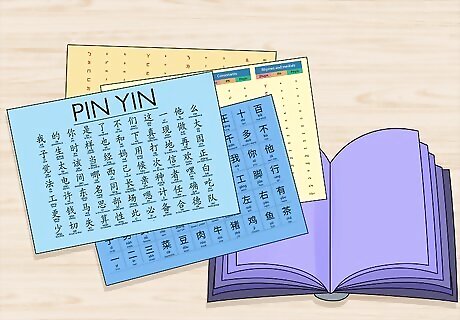
Familiarize yourself with Pinyin to learn how to pronounce new words. Pinyin is a system used for writing Mandarin Chinese using the Roman alphabet. Hanyu Pinyin is the most common form of such Romanization and is used in many textbooks and teaching materials. Pinyin allows students of Mandarin to focus on their pronunciation, while also enabling them to read and write, without needing to learn complex Chinese characters. Although Pinyin uses the Roman alphabet, the pronunciation of its letters is often not intuitive to English speakers, which is why it must be studied carefully before it can be used. For example, the letter "c" in Pinyin is pronounced like the "ts" in the word "bits", the letter "e" is pronounced like the "er" in the word "hers" and the letter "q" is pronounced like the "ch" in the word "cheap". Due to these differences, it’s important to learn the correct Pinyin pronunciations before using it as a guide. Although learning Pinyin pronunciations may seem like a pain, it can be extremely beneficial to your language learning and is still significantly easier than learning to recognize the traditional Chinese characters. Tip: Keep in mind that the tone (symbol) above each letter should be placed on top of a vowel that is first in the alphabet. This means that it’s “hǎo” and not “haǒ.”
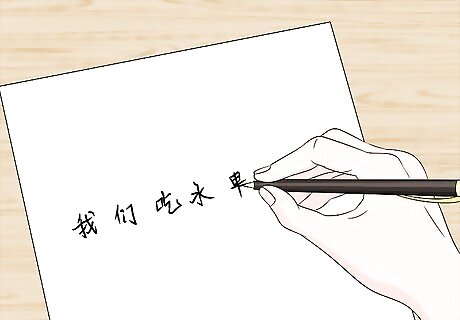
Practice reading and writing Chinese characters. Learn the formal process for writing traditional Chinese characters, including stroke order and each character’s individual components, called “radicals.” This process will take time, as the only way to learn Chinese characters is through memorization and continuous practice. According to the BBC, there are over 50,000 Chinese characters in existence, however, most of these are rarely, if ever, used. An educated Chinese person will probably know about 8000 characters, but only about 2000 of these are necessary to read a newspaper. Familiarize yourself with the 214 "radicals.” These are specific symbols that come together to form all Chinese characters. Some radicals can stand on their own as independent characters, while others are used only within more complex characters. Always follow the correct stroke order when writing the characters. There are specific rules to follow, such as left to right, top to bottom, and horizontal before vertical, depending on the character. There are many Chinese workbooks available that teach you how to write characters. These are usually intended for schoolchildren, but are useful to anyone attempting to learn Chinese characters. IBuy one which is designed for English speakers. For example, 快乐汉语 from Hanban has an English translation.
Immersing Yourself in the Language

Practice speaking with a native Mandarin speaker. Ask them to correct any grammar or pronunciation mistakes you make. Have them suggest more informal or colloquial speech that you won't find in a textbook. If you have a Mandarin-speaking friend, ask if they are willing to practice speaking with you. Otherwise, search online for Mandarin conversation groups in your area. If you can't locate any Mandarin speakers nearby, search online for language exchange programs with Mandarin speakers who are learning English. Some may be willing to exchange 15 minutes of Mandarin conversation for 15 minutes of English. Join [QQ, a chat service that is very popular in China featuring many language learning groups/rooms. Most members are native Chinese speakers learning English.
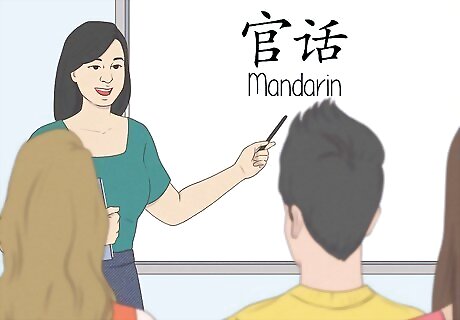
Take Mandarin language courses. Do this if you prefer to learn in a more formal setting, or if you enjoy being motivated by an instructor. In-person classes are often available in Chinese-American communities, while online courses are available nationwide. Prices range from $300 to $500 or more per year, not including textbooks and other course materials. Check for Mandarin courses at a local college, university, school, or community center. If you are currently enrolled at a college or university, take a Mandarin course at your institution.

Watch Chinese films and cartoons. Stream or download Mandarin movies and cartoons with English subtitles. This is an easy, entertaining way to get a feel for the sound and structure of the Mandarin Chinese language. Pause the video after a simple sentence and repeat what has just been said. This will lend your Chinese accent an air of authenticity! Check your local library for Chinese films, or ask if they’re able to obtain some for you.

Listen to Chinese podcasts, music, and radio. This will familiarize you with the sound of the language. Don’t worry if you can’t understand everything you hear. Listen carefully and pick out keywords to get the gist of what's being said. Get a Mandarin Chinese radio app on your phone and listen to it on the go. Download Chinese podcasts to listen to while exercising or doing housework.

Visit China to immerse yourself in the language. Once you feel comfortable with the basics of Mandarin Chinese speech, take a trip to China. Practice Mandarin with native speakers to learn how to use the language in daily life. Study abroad in China if you are currently enrolled in a college or university. This allows you to study Mandarin in China while earning credit towards your degree. Participate in an international exchange program, such as Rotary International, which allows students to live with a host family in China for up to a year. You’ll need permission from a parent or guardian if you’re under 18. EXPERT TIP Godspeed Chen Godspeed Chen Native Chinese Speaker & Translator Godspeed Chen is a Professional Translator from China. He has been working in translation and localization for over 15 years. Godspeed Chen Godspeed Chen Native Chinese Speaker & Translator Our Expert Agrees: The best way to learn Mandarin, like most other languages, is full immersion. Living in or visiting China will help you learn Mandarin much faster.

Be patient and remember that learning Mandarin takes time. Most English speakers need at least 2200 hours of intensive practice to become conversational in Mandarin. The actual time frame depends on many factors, including your natural ability and previous experience learning other languages. Either way, your fluency will improve with practice. 2200 hours is the estimate for reaching “General Professional Proficiency,” according to the U.S. State Department, which provides foreign language training to U.S. diplomats. This means it takes roughly 2200 hours of study to be able to speak Mandarin in formal situations, such as with coworkers, but you won’t necessarily be completely fluent.


















Comments
0 comment